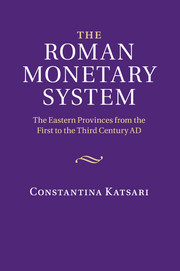Book contents
- Frontmatter
- Contents
- List of charts
- Acknowledgements
- List of abbreviations
- Framing the Roman Monetary System: An Introduction
- 1 Statistics and numismatics
- 2 Planning the financial policy of the Roman state
- 3 Trimetallism and bimetallic laws
- 4 The application of the Quantity Theory of Money to third-century economics
- 5 Roman monetary integration
- 6 Micro-economies
- 7 Metallism vs. chartalism
- Appendix 1 The inscription of Mylasa
- Appendix 2 Excavations finds, coin hoards and museums
- References
- Index
7 - Metallism vs. chartalism
Published online by Cambridge University Press: 01 March 2011
- Frontmatter
- Contents
- List of charts
- Acknowledgements
- List of abbreviations
- Framing the Roman Monetary System: An Introduction
- 1 Statistics and numismatics
- 2 Planning the financial policy of the Roman state
- 3 Trimetallism and bimetallic laws
- 4 The application of the Quantity Theory of Money to third-century economics
- 5 Roman monetary integration
- 6 Micro-economies
- 7 Metallism vs. chartalism
- Appendix 1 The inscription of Mylasa
- Appendix 2 Excavations finds, coin hoards and museums
- References
- Index
Summary
In this study we identified four different socioeconomic factors that affected the operation of the monetary system in the Roman empire: (a) the emperor, (b) the elite, (c) the ‘middling’ social groups and (d) the poor inhabitants. The emperor was responsible for the overall supervision of the production of money (minting and mining) and the control of revenues and expenses. Even if he did not devise long-lasting economic strategies, his monetary policies aimed at solving his financial problems and regulating the markets in an effective manner. The elite, on the other hand, may not have participated in the production of coins but they used them extensively in private business activities. Merchants, bankers and other entrepreneurs, who belonged either to the elite or the ‘middling’ social group, were responsible for the movement of predominantly precious-metal coins from one area to the other, thus creating unified circulation pools. In addition, they used credit in order to reduce transaction costs. Finally, the lower social strata used in local markets either civic or ‘official’ bronze coins. Although the value of these denominations was small, their significance for the monetary economy was high, since they facilitated daily transactions.
The different parts of the monetary economy functioned perfectly together. From this perspective, the Roman economy resembled a chain; if one of the links (production, distribution, weight standards, exchange rates etc.) changed, the other ones needed to adjust. Furthermore, it seems that the economy was intimately connected to the political and social conditions predominant at the time.
- Type
- Chapter
- Information
- The Roman Monetary SystemThe Eastern Provinces from the First to the Third Century AD, pp. 244 - 253Publisher: Cambridge University PressPrint publication year: 2011



